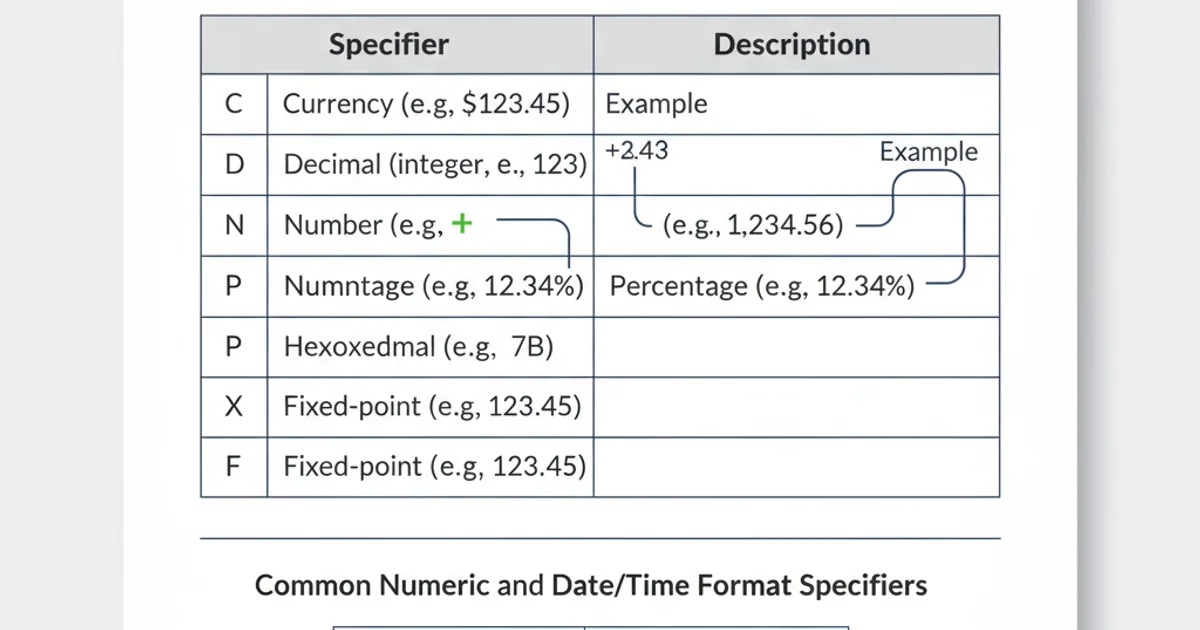string.format syntax in c# and what it does?
Categories:
Mastering C# string.Format: A Comprehensive Guide to Formatted Output

Explore the power and versatility of C#'s string.Format method for creating well-structured and readable string output, including its syntax, format specifiers, and practical applications.
In C#, string.Format is a fundamental method for constructing strings by embedding values into a composite format string. It provides a powerful and flexible way to control the appearance of data, making your output more readable and consistent. This article will delve into the syntax, common format specifiers, and practical scenarios where string.Format shines, including its relevance in contexts like SSIS expressions.
Understanding the Basic Syntax of string.Format
The core of string.Format involves a format string containing placeholders and a list of objects whose values are to be inserted into those placeholders. Each placeholder is represented by a number enclosed in curly braces, like {0}, {1}, etc., corresponding to the zero-based index of the arguments provided after the format string.
string name = "Alice";
int age = 30;
double salary = 55000.75;
// Basic usage
string message1 = string.Format("Hello, {0}! You are {1} years old.", name, age);
Console.WriteLine(message1);
// Using format specifiers for currency
string message2 = string.Format("{0} earns {1:C} annually.", name, salary);
Console.WriteLine(message2);
// Aligning text
string message3 = string.Format("|{0,-10}|{1,10}|", "Item", "Price");
string message4 = string.Format("|{0,-10}|{1,10:C}|", "Laptop", 1200.50);
Console.WriteLine(message3);
Console.WriteLine(message4);
Basic examples demonstrating string.Format with placeholders and format specifiers.
flowchart TD
A[Start: Define Variables] --> B{string.Format("Hello, {0}!", name)};
B --> C[Output: "Hello, Alice!"];
C --> D{string.Format("{0:C}", salary)};
D --> E[Output: "$55,000.75"];
E --> F[End];Flowchart illustrating the basic operation of string.Format.
Common Format Specifiers and Their Usage
string.Format offers a rich set of format specifiers that allow you to control how different data types are presented. These specifiers are appended to the placeholder index, separated by a colon (e.g., {0:C}).
CultureInfo.InvariantCulture as the first argument to string.Format.
Common Numeric and Date/Time Format Specifiers
DateTime now = DateTime.Now;
double percentage = 0.85;
int largeNumber = 123456789;
// Date and Time
Console.WriteLine(string.Format("Current Date: {0:d}", now)); // Short date
Console.WriteLine(string.Format("Current Time: {0:T}", now)); // Long time
Console.WriteLine(string.Format("Full Date/Time: {0:F}", now)); // Full date/time (long time)
Console.WriteLine(string.Format("Custom Format: {0:yyyy-MM-dd HH:mm:ss}", now));
// Numeric
Console.WriteLine(string.Format("Percentage: {0:P1}", percentage)); // 85.0%
Console.WriteLine(string.Format("Number with thousands separator: {0:N0}", largeNumber)); // 123,456,789
Console.WriteLine(string.Format("Hexadecimal: {0:X}", 255)); // FF
Console.WriteLine(string.Format("Fixed-point (2 decimal places): {0:F2}", 123.456)); // 123.46
Examples of various format specifiers for dates, times, and numbers.
Alignment and Padding with string.Format
Beyond simple formatting, string.Format also allows you to control the alignment and padding of your output. By adding a comma and a positive or negative integer after the placeholder index (e.g., {0,10} or {0,-10}), you can specify the minimum width of the field and its alignment.
string item1 = "Apple";
decimal price1 = 1.25m;
string item2 = "Banana";
decimal price2 = 0.79m;
Console.WriteLine(string.Format("|{0,-15}|{1,10}|", "Product", "Price"));
Console.WriteLine(string.Format("|{0,-15}|{1,10:C2}|", item1, price1));
Console.WriteLine(string.Format("|{0,-15}|{1,10:C2}|", item2, price2));
// Output:
// |Product | Price|
// |Apple | $1.25|
// |Banana | $0.79|
Using alignment specifiers for tabular output.
string.Format in SSIS Expressions
While string.Format is a C# method, the concept of formatted string output is crucial in other environments. In SQL Server Integration Services (SSIS), you often need to construct dynamic strings for file paths, log messages, or SQL queries. SSIS expressions use a slightly different syntax, but the underlying principle of combining literals with variable values remains the same. The (DT_WSTR, length) cast and string concatenation (+) are commonly used to achieve similar results.
// Example SSIS Expression for a file path
"C:\Data\Reports\" + (DT_WSTR, 4)YEAR(GETDATE()) + "-" + RIGHT("0" + (DT_WSTR, 2)MONTH(GETDATE()), 2) + "-" + RIGHT("0" + (DT_WSTR, 2)DAY(GETDATE()), 2) + ".csv"
// Equivalent C# string.Format for comparison
// string filePath = string.Format("C:\\Data\\Reports\\{0:yyyy-MM-dd}.csv", DateTime.Now);
Comparing SSIS expression string construction with C# string.Format.